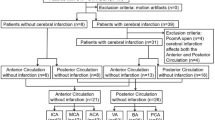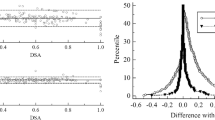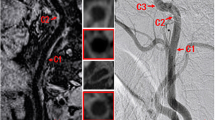Abstract
Objectives
To compare three-dimensional high-resolution magnetic resonance imaging (3D HR-MRI) and digital subtraction angiography (DSA) for diagnosing and evaluating stenosis in the entire circle of Willis.
Methods
The study included 516 intracranial arteries from 43 patients with intracranial artery stenosis (ICAS) who underwent both 3D HR-MRI and DSA within 1 month. Two readers independently diagnosed atherosclerosis, dissection, moyamoya disease and vasculitis, rated their diagnostic confidence for each vessel and measured the luminal diameters. Reference standard was made from clinico-radiologic diagnosis. Diagnostic accuracy, diagnostic confidence, the degree of stenosis and luminal diameter were assessed and compared between both modalities.
Results
For atherosclerosis, 3D HR-MRI showed better diagnostic accuracy (P = .03–.003), sensitivity (P = .006–.01) and positive predictive value (P ≤ .001–.006) compared to DSA. Overall, the readers were more confident of their diagnosis of ICAS when using 3D HR-MRI (reader 1, P ≤ .001–.007; reader 2, P ≤ .001–.015). 3D HR-MRI showed similar degree of stenosis (P > .05) and higher luminal diameter (P < .05) compared to DSA.
Conclusions
3D HR-MRI might be useful to evaluate atherosclerosis, with better diagnostic confidence and comparable stenosis measurement compared to DSA in the entire circle of Willis.
Key Points
• 3D HR-MRI showed better diagnostic accuracy for atherosclerosiscompared to DSA
• 3D HR-MRI showed better overall diagnostic confidence for stenosiscompared to DSA
• 3D HR-MRI and DSA showed similar degree of stenosis




Similar content being viewed by others
Abbreviations
- 2D:
-
two-dimensional
- 3D:
-
three-dimensional
- DSA:
-
digital subtraction angiography
- GEE:
-
generalized estimating equation
- HR-MRI:
-
high-resolution magnetic resonance imaging
- ICAS:
-
intracranial artery stenosis
- PPV:
-
positive predictive value
References
Ingall T (2004) Stroke–incidence, mortality, morbidity and risk. J Insur Med 36:143–152
Alexander MD, Yuan C, Rutman A et al (2016) High-resolution intracranial vessel wall imaging: imaging beyond the lumen. J Neurol Neurosurg Psychiatry 87:589–597
Bhogal P, Navaei E, Makalanda HL et al (2015) Intracranial vessel wall MRI. Clin Radiol
Choi YJ, Jung SC, Lee DH (2015) Vessel wall imaging of the intracranial and cervical carotid arteries. J Stroke 17:238–255
Swartz RH, Bhuta SS, Farb RI et al (2009) Intracranial arterial wall imaging using high-resolution 3-tesla contrast-enhanced MRI. Neurology 72:627–634
Dieleman N, van der Kolk AG, Zwanenburg JJ et al (2014) Imaging intracranial vessel wall pathology with magnetic resonance imaging: current prospects and future directions. Circulation 130:192–201
Kim YS, Lim SH, Oh KW et al (2012) The advantage of high-resolution MRI in evaluating basilar plaques: a comparison study with MRA. Atherosclerosis 224:411–416
Li ML, Xu WH, Song L et al (2009) Atherosclerosis of middle cerebral artery: evaluation with high-resolution MR imaging at 3T. Atherosclerosis 204:447–452
Xu WH, Li ML, Niu JW, Feng F, Jin ZY, Gao S (2014) Intracranial artery atherosclerosis and lumen dilation in cerebral small-vessel diseases: a high-resolution MRI Study. CNS Neurosci Ther 20:364–367
Kwak HS, Hwang SB, Chung GH, Jeong SK (2014) High-resolution magnetic resonance imaging of symptomatic middle cerebral artery dissection. J Stroke Cerebrovasc Dis 23:550–553
Bley TA, Uhl M, Carew J et al (2007) Diagnostic value of high-resolution MR imaging in giant cell arteritis. AJNR Am J Neuroradiol 28:1722–1727
Mandell DM, Matouk CC, Farb RI et al (2012) Vessel wall MRI to differentiate between reversible cerebral vasoconstriction syndrome and central nervous system vasculitis: preliminary results. Stroke 43:860–862
Kim YJ, Lee DH, Kwon JY et al (2013) High resolution MRI difference between moyamoya disease and intracranial atherosclerosis. Eur J Neurol 20:1311–1318
Ryoo S, Cha J, Kim SJ et al (2014) High-resolution magnetic resonance wall imaging findings of moyamoya disease. Stroke 45:2457–2460
Obusez EC, Hui F, Hajj-Ali RA et al (2014) High-resolution MRI vessel wall imaging: spatial and temporal patterns of reversible cerebral vasoconstriction syndrome and central nervous system vasculitis. AJNR Am J Neuroradiol 35:1527–1532
Zhang L, Zhang N, Wu J et al (2015) High resolution three dimensional intracranial arterial wall imaging at 3 T using T1 weighted SPACE. Magn Reson Imaging 33:1026–1034
Qiao Y, Steinman DA, Qin Q et al (2011) Intracranialarterial wall imaging using three-dimensional high isotropic resolution black blood MRI at 3.0 Tesla. J Magn Reson Imaging 34:22–30
Garg SK, Mohan S, Kumar S (2011) Diagnostic value of 3D contrast-enhanced magnetic resonance angiography in Takayasu's arteritis–a comparative study with digital subtraction angiography. Eur Radiol 21:1658–1666
Aoki S, Yoshikawa T, Hori M et al (2000) Two-dimensional thick-slice MR digital subtraction angiography for assessment of cerebrovascular occlusive diseases. Eur Radiol 10:1858–1864
Chung TS, Joo JY, Lee SK, Chien D, Laub G (1999) Evaluation of cerebral aneurysms with high-resolution MR angiography using a section-interpolation technique: correlation with digital subtraction angiography. AJNR Am J Neuroradiol 20:229–235
Kaufmann TJ, Huston J 3rd, Mandrekar JN, Schleck CD, Thielen KR, Kallmes DF (2007) Complications of diagnostic cerebral angiography: evaluation of 19,826 consecutive patients. Radiology 243:812–819
Soize S, Bouquigny F, Kadziolka K, Portefaix C, Pierot L (2014) Value of 4D MR angiography at 3T compared with DSA for the follow-up of treated brain arteriovenous malformation. AJNR Am J Neuroradiol 35:1903–1909
Tsushima Y, Aoki J, Endo K (2003) Contribution of the diagnostic test to the physician's diagnostic thinking: new method to evaluate the effect. Acad Radiol 10:751–755
Fryback DG, Thornbury JR (1991) The efficacy of diagnostic imaging. Med Decis Making 11:88–94
Seo N, Park SH, Kim KJ et al (2016) MR enterography for the evaluation of small-bowel inflammation in Crohn disease by using diffusion-weighted imaging without intravenous contrast material: a prospective noninferiority study. Radiology 278:762–772
Lee NJ, Chung MS, Jung SC et al (2016) Comparison of high-resolution MR imaging and digital subtraction angiography for the characterization and diagnosis of intracranial artery disease. AJNR Am J Neuroradiol 37:2245–2250
Chimowitz MI, Kokkinos J, Strong J et al (1995) Thewarfarin-aspirin symptomatic intracranial disease study. Neurology 45:1488–1493
Landis JR, Koch GG (1977) The measurement of observer agreement for categorical data. Biometrics 33:159–174
Mossa-Basha M, de Havenon A, Becker KJ et al (2016) Added value of vessel wall magnetic resonance imaging in the differentiation of moyamoya vasculopathies in a non-Asian cohort. Stroke 47:1782–1788
Klein IF, Lavallee PC, Schouman-Claeys E, Amarenco P (2005) High-resolution MRI identifies basilar artery plaques in paramedian pontine infarct. Neurology 64:551–552
Xu WH, Li ML, Gao S et al (2010) In vivo high-resolution MR imaging of symptomatic and asymptomatic middle cerebral artery atherosclerotic stenosis. Atherosclerosis 212:507–511
Lee WJ, Choi HS, Jang J et al (2015) Non-stenotic intracranial arteries have atherosclerotic changes in acute ischemic stroke patients: a 3T MRI study. Neuroradiology 57:1007–1013
Kontzialis M, Wasserman BA (2016) Intracranial vessel wall imaging: current applications and clinical implications. Neurovascular Imaging 2:1–6
de Havenon A, Yuan C, Tirschwell D et al (2015) Nonstenotic culprit plaque: the utility of high-resolution vessel wall MRI of intracranial vessels after ischemic stroke. Case Rep Radiol 2015:356582
Liu Q, Huang J, Degnan AJ et al (2013) Comparison of high-resolution MRI with CT angiography and digital subtraction angiography for the evaluation of middle cerebral artery atherosclerotic steno-occlusive disease. Int J Cardiovasc Imaging 29:1491–1498
Saam T, Hetterich H, Hoffmann V et al (2013) Meta-analysis and systematic review of the predictive value of carotid plaque hemorrhage on cerebrovascular events by magnetic resonance imaging. JAmCollCardiol 62:1081–1091
Zhang YY, Guallar E, Qiao Y, Wasserman BA (2014) Is carotid intima-media thickness as predictive as other noninvasive techniques for the detection of coronary artery disease? Arterioscler Thromb Vasc Biol 34:1341–1345
Natori T, Sasaki M, Miyoshi M et al (2014) Evaluating middle cerebral artery atherosclerotic lesions in acute ischemic stroke using magnetic resonance T1-weighted 3-dimensional vessel wall imaging. J Stroke Cerebrovasc Dis 23:706–711
Research Committee on the Pathology and Treatment of Spontaneous Occlusion of the Circle of Willis (2012) Guidelines for diagnosis and treatment of moyamoya disease (spontaneous occlusion of the circle of Willis). Neurol Med Chir (Tokyo) 52:245–266
Fox AJ, Millar J, Raymond J et al (2009) Dangerous advances in measurements from digital subtraction angiography: when is a millimeter not a millimeter? Am J Neuroradiol 30:459–461
Boussion N, Soulez G, De Guise JA, Daronat M, Qin Z, Cloutier G (2004) Geometrical accuracy and fusion of multimodal vascular images: a phantom study. Med Phys 31:1434–1443
Choi CG, Lee DH, Lee JH et al (2007) Detection of intracranial atherosclerotic steno-occlusive disease with 3D time-of-flight magnetic resonance angiography with sensitivity encoding at 3T. AJNR Am J Neuroradiol 28:439–446
Author information
Authors and Affiliations
Corresponding author
Ethics declarations
Guarantor
The scientific guarantor of this publication is Sang Joon Kim.
Conflict of interest
The authors of this manuscript declare no relationships with any companies whose products or services may be related to the subject matter of the article.
Funding
This research was supported by the Korea Healthcare Technology R&D Project, Ministry of Health, Welfare, and Family Affairs, Republic of Korea (grant number -HI12C1847).
Statistics and biometry
One of the authors has significant statistical expertise (Seon-Ok Kim).
Ethical approval
Institutional review board approval was obtained.
Informed consent
Written informed consent was waived by the institutional review board.
Methodology
-
retrospective
-
diagnostic study
-
performed at one institution
Rights and permissions
About this article
Cite this article
Park, J.E., Jung, S.C., Lee, S.H. et al. Comparison of 3D magnetic resonance imaging and digital subtraction angiography for intracranial artery stenosis. Eur Radiol 27, 4737–4746 (2017). https://doi.org/10.1007/s00330-017-4860-6
Received:
Revised:
Accepted:
Published:
Issue Date:
DOI: https://doi.org/10.1007/s00330-017-4860-6




